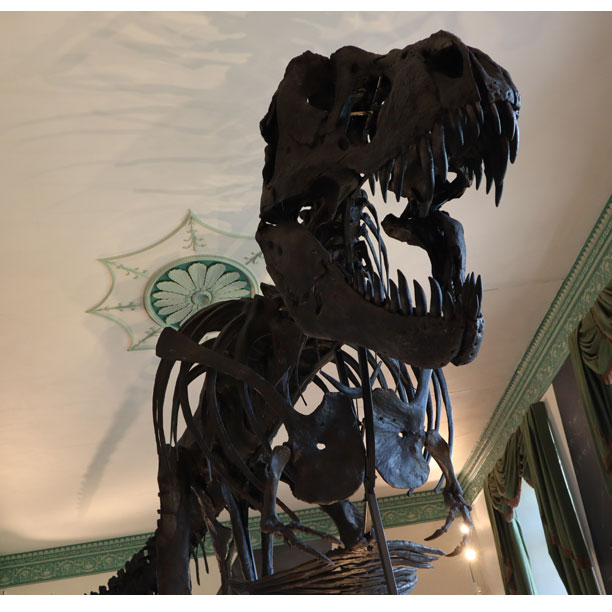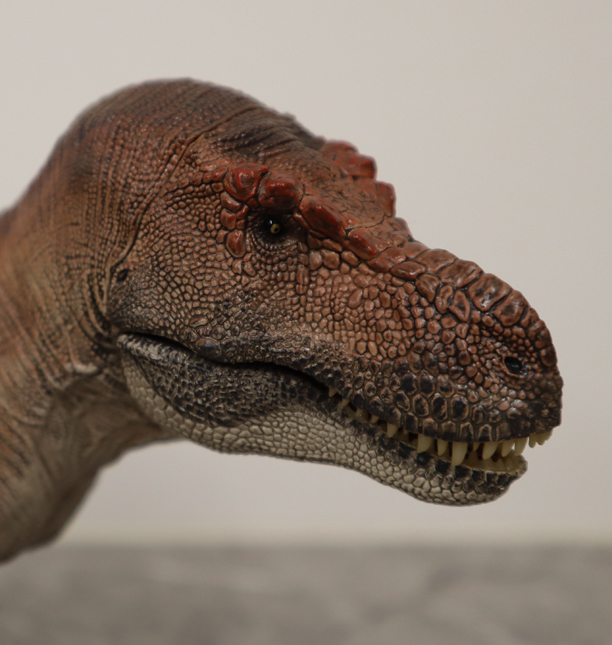New scientific research has challenged the findings of a 2023 study that concluded T. rex may have been as clever as a primate. How smart was T. rex? That is a fascinating question, one that body and trace fossils cannot really answer. The idea that the Dinosauria were slow, lumbering, stupid giants has largely been debunked. However, scientists have continued to puzzle over their cognitive abilities.
In April 2023, Everything Dinosaur blogged about a controversial study by Dr Suzana Herculano-Houzel from the Department of Psychology at Vanderbilt University (Tennessee). Doctor Herculano-Houzel postulated that Tyrannosaurus rex had around 3 billion cerebral neurons. The Brazilian neuroscientist implied that this super-sized predator had cognitive capabilities that matched primates.

The spectacular Titus the T. rex exhibit at Wollaton Hall. How smart was T. rex? A newly published paper challenges an earlier study that postulated that this theropod was as clever as an extant primate. Picture credit: Everything Dinosaur.
Picture credit: Everything Dinosaur
The earlier paper proposed that large theropods such as Tyrannosaurus rex were long-lived, and remarkably intelligent. It was postulated that these animals had “macaque or baboon-like cognition”.
To read Everything Dinosaur’s blog post about this paper: How Big was a T. rex Brain?
Challenging Established Views About Dinosaur Intelligence
The research challenged established views on dinosaur biology and inferred behaviours. In addition, the earlier paper raised questions about whether neuron count estimates could benefit research on extinct animals in general. However, a team of international scientists, including Dr Darren Naish (University of Southampton), have refuted these claims. In a study published in “The Anatomical Record”, the researchers conclude that Tyrannosaurus rex was probably about as smart as a modern crocodile.
Their work reaffirms older theories about the intelligence of large theropods. Soft tissue structures like dinosaur brains rarely survive as fossils. Scientists can use endocasts, moulds made of the brain cavity to estimate brain size and structure. This is imperfect. For example, in extant crocodilians the brain only occupies about a third of the cranial cavity. In mammals and birds nearly 100% of this cavity is occupied by the brain. By revisiting Herculano-Houzel’s (2023) work, the researchers identified several crucial discrepancies regarding interpretation and analysis of data.
Dr Herculano-Houzel probably overestimated the size of the brain of T. rex. It was assumed that the brain filled the whole of the endocranial cavity. In essence, the brain size of T. rex was modelled on mammals and birds, but this new study suggests crocodilians are a better analogy.

Blue: olfactory bulb and tracts, Green: pallium (homologous to the mammalian cerebral cortex), Orange: cerebellum, Yellow: diencephalon and optic tectum, Violet: brain stem. Olfactory structures, pallium and subpallium comprise the telencephalon. The overlay in grey indicates extinct taxa, the brain morphologies of which are estimated. The brain morphology of extinct ornithodirans is similar when compared to living reptiles. Picture credit: Caspar et al.
How Smart was T. rex?
The data used by Dr Herculano-Houzel was found to be inconsistent. For instance, brain size estimates had included other structures that are located in the cranium, but not part of the brain, the olfactory bulb for example. In addition, the earlier study had used a mixture of both juvenile and adult tyrannosaurs. The use of not fully mature animals in the study could have led to inaccurate results.
The team revised the estimates of encephalisation and telencephalic neuron counts in the Dinosauria. For large-bodied theropods in particular, this study estimated significantly lower neuron counts than previously proposed. Their phylogenetic modelling indicated a neuron count for T. rex at between 250 million and 1.7 billion neurons. Although the data spread was substantial, the results modelled reflect the neuron counts found in extant crocodilians. This dataset did not produce neuron counts approaching those found in primates.

A close-up view of the detail on the head of the Rebor T. rex Tusk dinosaur model. Although this theropod was a formidable predator, its intelligence may have been overestimated. Picture credit: Everything Dinosaur.
Picture credit: Everything Dinosaur
The image (above) shows a close-up view of a 1:35 scale model of a Rebor Tyrannosaurus rex.
To view the Rebor range of prehistoric animals available from Everything Dinosaur: Rebor Dinosaur and Prehistoric Animal Figures.
Brain Size May Not Represent the Best Measure of Cognitive Abilities
Furthermore, the researchers reviewed the suitability of neurological variables such as neuron numbers and relative brain size to predict cognitive complexity, metabolic rate and life history traits in dinosaurs. They concluded that these measures are not helpful when trying to assess the cognition of extinct creatures.
The team stated that trying to gauge the cognitive abilities of dinosaurs without close living analogues is extremely challenging. Neuron numbers might be considered a minor component in an assessment of intelligence and much more work is required to build a robust framework to better understand the level of cognition in extinct animals. In addition, the team concluded that given the depiction of dinosaurs in the popular media, researchers should acknowledge the limitations of the presented inferences to allow their audience to delineate between reasoned conclusions and speculation.
So, when it comes to calculating how smart was T. rex? Scientists have yet to devise robust models to explore dinosaur intelligence.
Everything Dinosaur acknowledges the assistance of the open-source paper (Caspar et al) published in the journal The Anatomical Record in the compilation of this article.
The scientific paper: “How smart was T. rex? Testing claims of exceptional cognition in dinosaurs and the application of neuron count estimates in palaeontological research” by Kai R. Caspar, Cristián Gutiérrez-Ibáñez, Ornella C. Bertrand, Thomas Carr, Jennifer A. D. Colbourne, Arthur Erb, Hady George, Thomas R. Holtz Jr, Darren Naish, Douglas R. Wylie and Grant R. Hurlburt published in The Anatomical Record.
Visit the award-winning Everything Dinosaur website: Dinosaur Models and Toys.






Leave A Comment